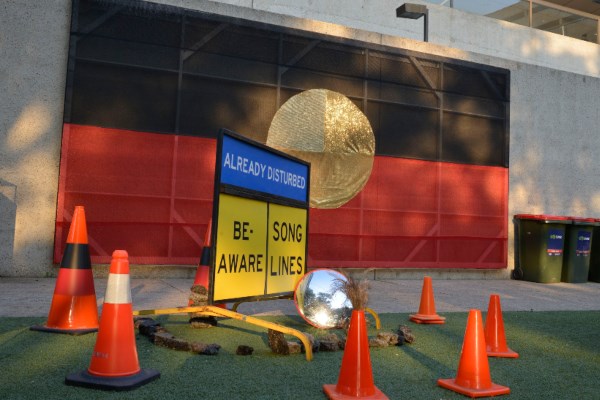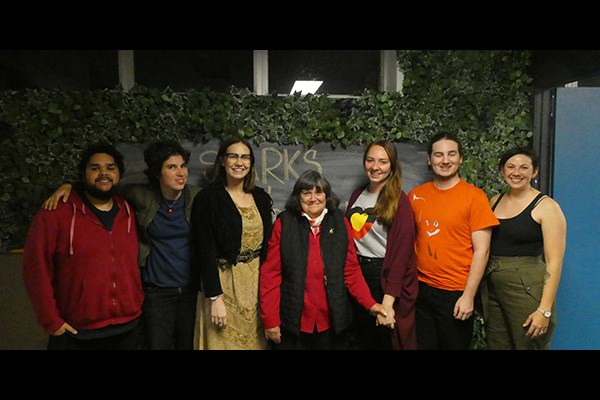During NAIDOC Week 2021, Our Chief Executive John Kotzas and Elder in Residence Aunty Colleen Wall sit down to talk about the performing arts’ role in ‘Healing Country’.
This year’s theme of ‘Heal Country!’ calls for all of us to continue to seek greater protections for our lands, our waters, our sacred sites and our cultural heritage from exploitation, desecration and destruction.

Already Occupied (2019) by Libby Harward at QPAC. Photo by Jo-Anne Driessens.
Aunty Col – a Senior Woman from the Dauwa (String Bark) Clan of the Ka’bvai or Kabi (Bee) Nation – kicks off the conversation:
“I think the only way to heal our Country, with most of us ‘living off Country’, is to continue to ‘sing it up’ by reminding it of the stories it holds. By continuing to talk to it in language, remind it how important it is to us.”
John agrees QPAC’s core business – creating and presenting art – is critical to maintaining a connection to Country.
“One of the great things that the arts does in general is bring people together to have a sense of belonging. Out of that belonging comes a sense of identity.
“We want all Australians to be respectful of where everyone has come from and understand where this country has been, and look at how we go forward together – that’s all part of instigating the healing that needs to happen in all of us.”
The pair have had many lengthy discussions about the importance of understanding the history and significance of QPAC as a place, with our Centre standing on the Ancient Freshwater Dreaming Pathway which is Stanley Street.
Aunty Col explains that bringing First Nations People into the building – to talk about Country, and use the energy from Country in the space – all works towards healing it.
Our Sparks program, where First Nations playwrights are supported by QPAC and Playlab Theatre to explore and develop new work, is a shining example of this.

Aunty Colleen Wall (centre) and Sparks playwrights.
“The more people we have working at QPAC in this way, the more opportunity we have to talk language, to sing songs and tell stories – this regenerates Country,” she says.
Both agree we shouldn’t be celebrating our First Nations Peoples for just one week a year, that is, First Nations Culture should be integrated into everything we do. For the industry and audience this means placing value on First Nations artists: listening to First Nations voices in the boardroom and on the stage, supporting the development of new First Nations work and creating career pathways from front of house to back of house, to name a few.
In wrapping up, Aunty Col talks to the power of the performing arts, and its ability to whisk the audience to another time or place.
“When we bring Bangarra in, for example, and they sing in language from the Northern Territory; that’s where it transports every person in that audience – to that space and that language. That’s the healing part for me.
John adds, “When we see someone on stage who offers us a mirror image of ourselves, then we feel that connection with that place and time, and story or idea. We need First Nations People to tell our nation’s story. Without this sense of belonging, we’re always going to be lost – without family, without land, and without Country.”
Aunty Col concludes:
“Even if you never go back to Country, it will always know you and hear you if you connect with it through song, dance or storytelling.”














